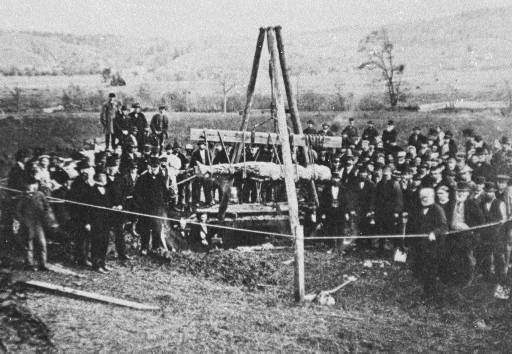 | ||
The Cardiff Giant was one of the most famous hoaxes in United States history. It was a 10-foot-tall (3.0 m) purported "petrified man" uncovered on October 16, 1869, by workers digging a well behind the barn of William C. "Stub" Newell in Cardiff, New York. Both it and an unauthorized copy made by P.T. Barnum are still on display.
Contents
Creation and discovery
The giant was the creation of a New York tobacconist named George Hull. Hull, an atheist, decided to create the giant after an argument at a Methodist revival meeting about Genesis 6:4 stating that there were giants who once lived on Earth.
The idea of a petrified man did not originate with Hull, however. In 1858 the newspaper Alta California had published a bogus letter claiming that a prospector had been petrified when he had drunk a liquid within a geode. Some other newspapers also had published stories of supposedly petrified people.
Hull hired men to carve out a 10-foot-4.5-inch-long (3.2 m) block of gypsum in Fort Dodge, Iowa, telling them it was intended for a monument to Abraham Lincoln in New York. He shipped the block to Chicago, where he hired Edward Burghardt, a German stonecutter, to carve it into the likeness of a man and swore him to secrecy.
Various stains and acids were used to make the giant appear to be old and weathered, and the giant's surface was beaten with steel knitting needles embedded in a board to simulate pores. In November 1868, Hull transported the giant by rail to the farm of his cousin, William Newell. By then, he had spent US$2,600 on the hoax (nearly $46,000 in 2015 dollars, adjusted for inflation).
Nearly a year later, Newell hired Gideon Emmons and Henry Nichols, ostensibly to dig a well, and on October 16, 1869 they found the giant. One of the men reportedly exclaimed, "I declare, some old Indian has been buried here!"
Exhibition and exposure as fraud
Newell set up a tent over the giant and charged 25 cents for people who wanted to see it. Two days later he increased the price to 50 cents. People came by the wagonload.
Archaeological scholars pronounced the giant a fake, and some geologists even noticed that there was no good reason to try to dig a well in the exact spot the giant had been found. Yale palaeontologist Othniel C. Marsh called it "a most decided humbug". Some theologians and preachers, however, defended its authenticity.
Eventually, Hull sold his part-interest for $23,000 (equivalent to $436,000 in 2016) to a syndicate of five men headed by David Hannum. They moved it to Syracuse, New York, for exhibition. The giant drew such crowds that showman P. T. Barnum offered $50,000 for the giant. When the syndicate turned him down, he hired a man to model the giant's shape covertly in wax and create a plaster replica. He put his giant on display in New York, claiming that his was the real giant, and the Cardiff Giant was a fake.
As the newspapers reported Barnum's version of the story, David Hannum was quoted as saying, "There's a sucker born every minute" in reference to spectators paying to see Barnum's giant. Over time, the quotation has been misattributed to Barnum himself.
Hannum sued Barnum for calling his giant a fake, but the judge told him to get his giant to swear on his own genuineness in court if he wanted a favorable injunction.
On December 10, Hull confessed to the press. On February 2, 1870 both giants were revealed as fakes in court. The judge ruled that Barnum could not be sued for calling a fake giant a fake.
Current resting place
The Cardiff Giant appeared in the 1901 Pan-American Exposition, but did not attract much attention.
Iowa publisher Gardner Cowles, Jr. bought it later to adorn his basement rumpus room as a coffee table and conversation piece. In 1947 he sold it to the Farmers' Museum in Cooperstown, New York, where it is still on display.
The owner of Marvin's Marvelous Mechanical Museum, a coin-operated game arcade and museum of oddities in Farmington Hills, Michigan, says that the replica on display there is Barnum's replica.
Imitators
The Cardiff Giant has inspired a number of similar hoaxes.
